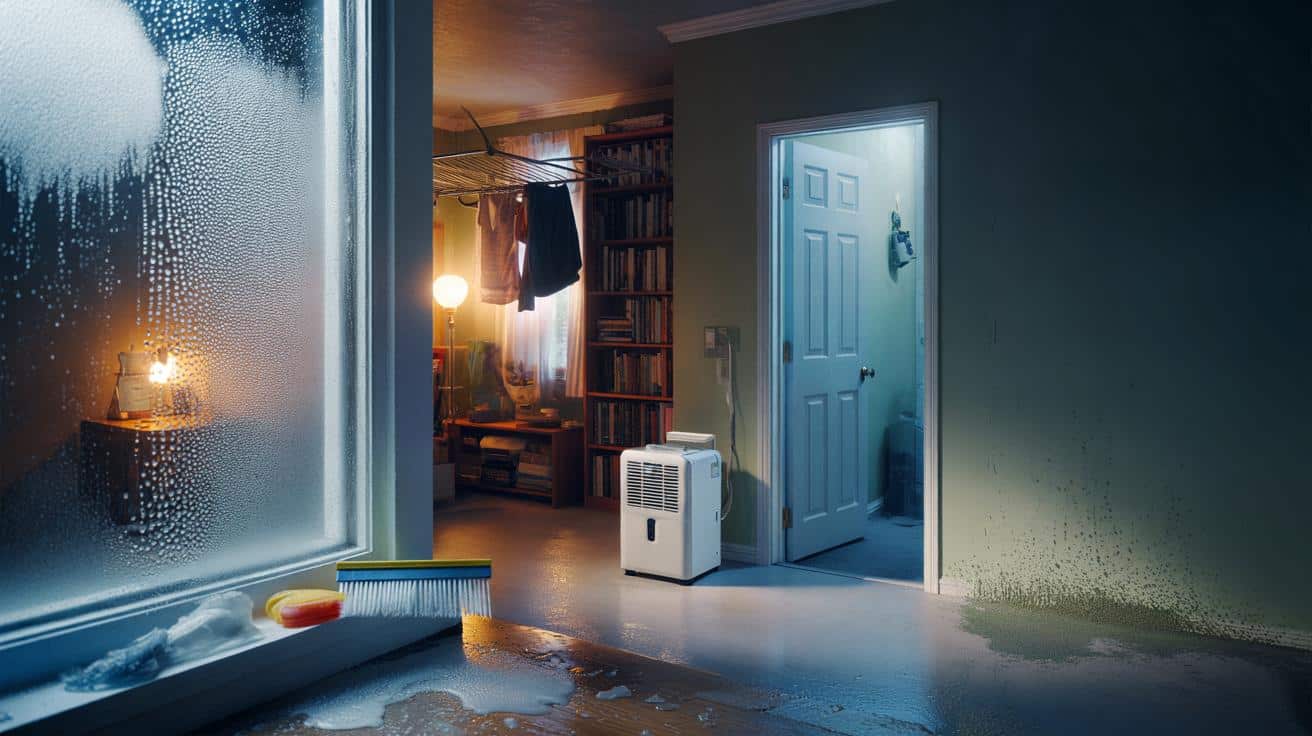When you can’t heat every room, the windows mist, the paint bubbles, and that sour smell settles in the corners you try not to look at. Condensation creeps in quietly, then mould shows up like a bad landlord. The trick isn’t more heat everywhere. It’s managing the air you have, and the water you make, day by day.
The kitchen steamed like a tiny spa at 7am. Kettle rattling, porridge burbling, the window blooming white from the bottom up. In the spare room, the duvet felt cool and a bit clammy, as if the night had left its breath on the walls. I wiped the sash with a tea towel, left a sliver of trickle vent open, and watched beads run into the frame. It felt small and slightly silly, but the room cleared. The wet glass told a story the thermostat can’t. The water’s already inside.
Why chilly rooms sweat — and where mould jumps in
Condensation is simple physics hiding in daily life. Warm, moist air meets a cold surface, hits its dew point, and drops water. In a home where only some rooms are heated, those unheated spaces become cold sinks. They pull moisture from the rest of the flat like a magnet. The result isn’t just misty panes. It’s damp skirting, stained plaster, swollen frames, and the perfect stage for mould to bloom.
We’ve all had that moment when you open a door to a colder room and get a waft of stale damp. In a semi in Leeds last winter, a couple told me their box room grew dots of black behind a bookcase every November. They ran the big radiator in the lounge, nothing upstairs. Laundry dried on a rail by the stairs. A cheap humidity meter on the shelf read 72% RH at 10pm, then 78% by morning. The mould didn’t arrive in a storm. It crept in through ordinary habits.
Mould needs three things: moisture, a food source and time. Homes generously provide two of those — dust and paint, plus patient corners behind furniture. Moisture is the only lever that moves fast. Heat helps, but heat alone won’t solve it if steam and breath have nowhere to go. Keep relative humidity under control and the whole dance changes. Less water on glass, fewer damp patches, and mould spores finding life harder on your walls.
Small moves that shift the moisture balance today
Start where moisture starts. Lids on pans, extractor on while cooking, and open it to the outside, not just a charcoal recirculator. After a shower, run the fan and keep the bathroom door closed for 20 minutes. In bedrooms, crack trickle vents and squeegee the windows each morning so you’re not leaving a lunchtime puddle in the frames. Put a dehumidifier where you live most, not buried in a corridor. Let it work while you dry laundry nearby. Aim the air across the room, not at a wall.
Doors are tiny thermostats. Keep warm lived-in rooms together with doors mostly open to each other, and doors shut on the cold rooms. That way you don’t chase your own breath into chilly boxes where it will condense. Dry clothes in one “moisture zone” with a fan or dehumidifier, rather than a little bit in every room. Let’s be honest: nobody actually does that every day. Still, one or two habits stick fast — and they pay off more than a blast of heat you can’t afford.
Keep doors shut on cold rooms so the warm, wet air doesn’t flood in and hit cold plaster. Leave a 10–15mm gap behind furniture on external walls, and lift boxes off floors in corners that look shady. Wipe small mould spots with detergent or a mould remover and a microfibre cloth, not a dry brush. Vent for five short minutes — windows wide, cross-draught — rather than a whole day of cracked-open heat loss. One brisk airing beats hours of slow, silent damp.
“Moisture is a budget you manage, not a battle you win once,” says a housing surveyor I met in Manchester. “You spend it cooking and breathing. You earn it back with airflow.”
- Aim for 40–60% RH on a simple humidity meter.
- Use extractor fans for 20 minutes after cooking or showering.
- Dry clothes in one room with a dehumidifier set to “laundry”.
- Open trickle vents and do a 5‑minute cross-vent once or twice a day.
- Move wardrobes 5cm off cold external walls.
The kit and choices that make winter easier
A small, quiet dehumidifier can be a winter workhorse. Place it on the landing or the living room where the air moves, and shut doors to concentrate its pull. Set a target around 50% RH, empty the tank daily, and clean the filter monthly. If budget allows, a model with a smart laundry mode will slash drying time and cut that musty smell. On windows, use thermal curtains or window film in the coldest rooms to lift glass temperature a notch. Not glamorous, but effective. Soyons honnêtes — ah, wrong language. The point stands.
Ventilation needs paths. Check bathroom and kitchen fans actually exhaust outside and aren’t choked with fluff. Crack a window for five minutes while the fan runs, then close it again. In older homes, trickle vents matter more than they look; open them enough to prevent overnight spikes. Don’t feed mould with accidental leaks: fix drips, clean gutters, and dry off window frames if you see water pooling. If you do treat patches, never mix products. Bleach and vinegar together produce a nasty gas. Simple beats clever.
Insulation helps, but don’t wait for a grant to act. Older solid walls can feel icy, which means dew point happens fast. A thin insulated liner or anti-condensation paint can buy you time in problem corners, yet they’re not magic. The wins stack when you combine small changes with light-touch heat. A low, steady radiator setting in lived-in zones outperforms on-off blasts. Use extractor fans for 20 minutes after cooking or showering and run a fan on low to keep air moving where you dry clothes. A cheap window vac each morning is not glamorous, but it’s honest work. You’ll see the bottle fill, and that’s water you won’t feed to the walls.
A wider reset for the season
This isn’t a perfect-home contest. It’s winter, money is tight, and the weather is doing its weather thing. Pick a humidity target, pick a drying zone, and choose which doors stay shut. That gives your place a rhythm. If you track RH on your phone for a week, you’ll spot the spikes — bath time, curry night, laundry day — and can nudge habits around those peaks. A five-minute cross-breeze, a fan that actually vents, a dehumidifier that hums while you sleep. Small moves, repeated, change the air in a home. And the air changes everything.
| Key points | Detail | Reader Interest |
|---|---|---|
| Control humidity | Target 40–60% RH with a meter and dehumidifier | Clear number to aim for, quick wins |
| Direct airflow | Fans and short cross-vents move moisture out fast | Low-cost actions with visible results |
| Protect cold spots | Shut doors to cold rooms, lift glass temperature, space furniture | Simple tweaks that cut condensation and mould |
FAQ :
- What’s the quickest way to cut morning window condensation?Run the bathroom/kitchen fan, open opposite windows for five minutes, then squeegee panes and frames. Park a dehumidifier nearby for the first hour.
- Should I leave the dehumidifier on at night?Yes in a closed drying zone or bedroom, set around 50% RH. It’s cheaper than blasting heat and slows mould growth while you sleep.
- Is drying laundry indoors always bad?Not if you control it. Keep it to one room, add airflow or a dehumidifier, and avoid bedrooms without ventilation. No radiators dripping onto cold walls.
- What do I clean small mould patches with?Use a mould remover or warm water with detergent. Wipe, rinse cloths, and bin them. Don’t dry-scrub and don’t mix bleach with vinegar.
- Do trickle vents make my home colder?They let moist air escape without a big heat dump. Open them a little, then do short, sharp cross-vents. The house feels fresher, not colder.








